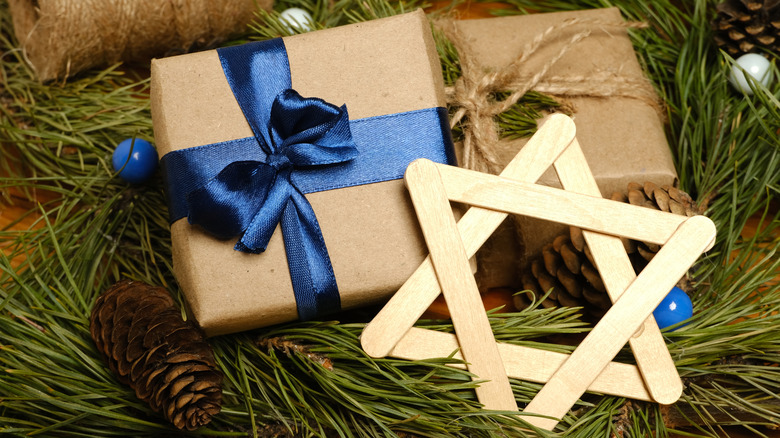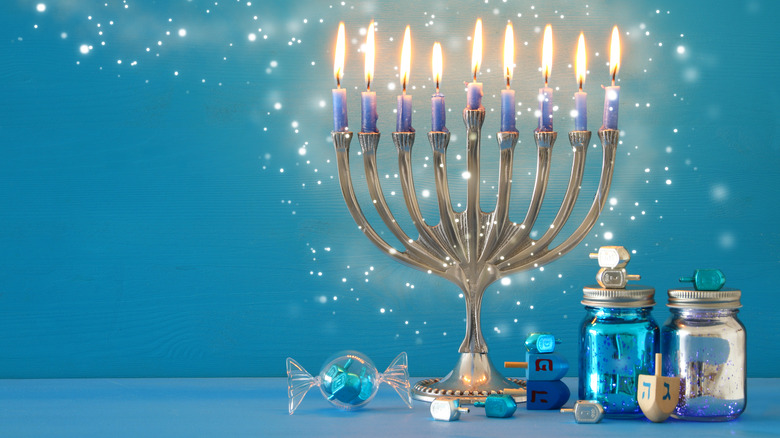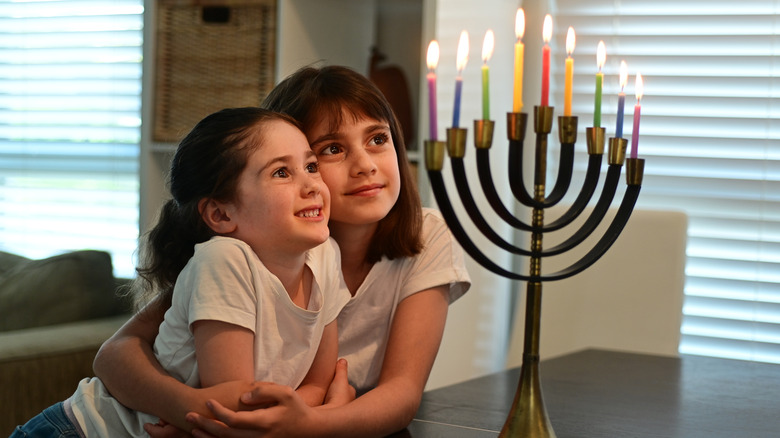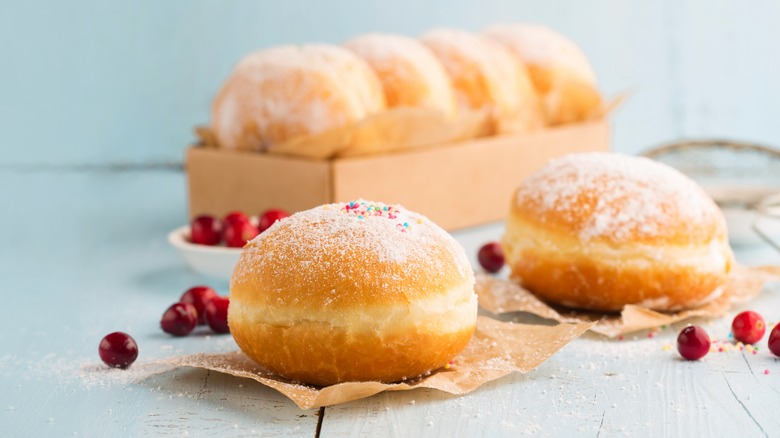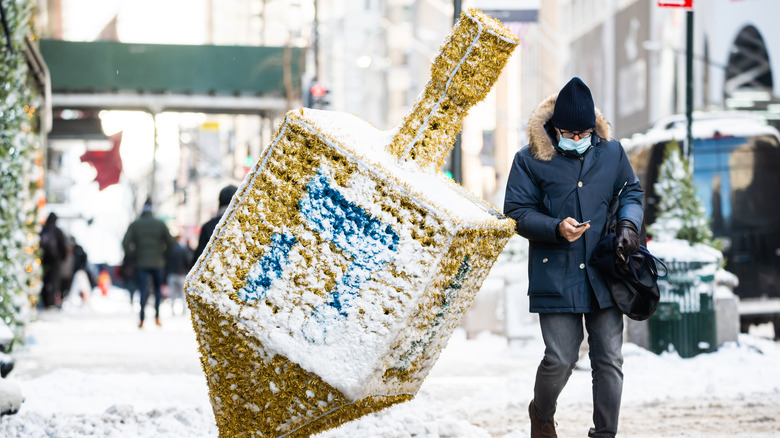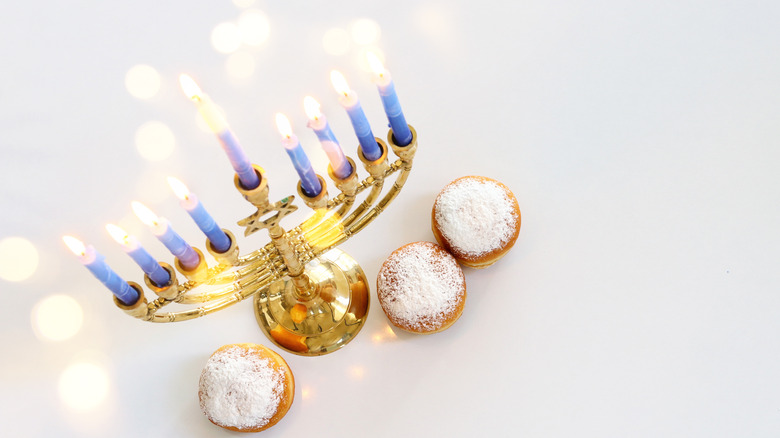The Untold Truth Of Hanukkah
For decades, American culture has collectively referred to the period at the end of the year as "the holidays." That's because, depending on how you define the period, at least two, and possibly three or more, major cultural and/or religious holidays occur during this time period. Throw in the beginning of a new year, and the long nights of winter can become a time of feasting, family, and remembrance.
One prominent holiday that takes place late in the calendar year is Hanukkah (or one of its multiple variant spellings). The "Festival of Lights," as Adam Sandler famously explains in "The Chanukah Song" (posted on YouTube), is a time for giving gifts, although he gleefully explains to his audience that it's not just one day of presents, but "eight crazy nights." This year, Hanukkah begins on Sunday, November 28 and continues through Monday, December 6. What sets Hanukkah apart from other holidays at that time of year (or any other time of the year, for that matter)?
Hanukkah celebrates a miracle
Hanukkah's roots are found in an event that took place in 165 B.C., according to Learn Religions. Specifically, the Jews, ruled by a foreign potentate, were forbidden from worshiping God. That foreign ruler, King Antiochus IV, had defiled the Jewish temple in Jerusalem with the blood of a pig — a particularly heinous act of vandalism, considering that, as Chabad explains, pigs are considered "unclean" in Judaism. The Jews rebelled, led by Judah Maccabee. Following a three-year war, they regained their freedom.
The Maccabees entered their temple with a view toward cleansing and rededicating it. According to the rules, there was to be lamps burning at all times, illuminating the building. The Maccabees found they only had enough oil to keep the lamps burning for one night, and it would be a week before new oil would arrive. Miraculously, however, the oil lasted for eight nights, continuing to burn because of God's presence, and that period of time set the basis for how the holiday is now remembered.
Lighting the menorah
Perhaps the most obvious visual symbol of Hanukkah is that of the menorah, a candelabra, such as can be seen in the image above, with eight branches for candles, plus a ninth in the center. As Chabad explains, the Hebrew word "menorah" means "lamp," as a similar lamp was used in the temple in Jerusalem when it was active. When Hanukkah rolls around each year, Jews who celebrate the holiday bring out the menorah to commemorate the rededication of the temple via lighting a candle — the light symbolizing the miraculously-burning oil in the temple. On each of the eight nights, a candle is lit, while a ninth candle, the "samash," or "helper," serves as the source of light for the other candles.
In a companion Chabad article, the writer notes that lighting the menorah should be a family affair. Children who are old enough to handle the task should be given the job of lighting a candle or two, or could even have their own menorahs and light them. The candles are to be lit from left to right, and each should burn for approximately 30 minutes.
Hanukkah celebrations often involve food
Many holidays, whether secular or religious, involve food, and Hanukkah is no exception. As Eat This, Not That! notes, foods fried in oil play a particular role in this celebration, emphasizing the holiday's roots in a miracle involving oil. Two particularly popular deep-fried Hanukkah foods are latkes, or fried potato cakes, often served with sides of sour cream and applesauce, and sufganiyot, which are deep-fried donuts filled with jelly or custard.
Moving away from the deep fryer, beef brisket and/or roasted chicken may turn up at the table during the festivities, as can other traditionally Jewish foods such as rugelach (a pastry), kugel (a kind of casserole), knish (a snack food), or matzo ball soup. Another popular Hanukkah food, particularly with children, is gelt, which are chocolate coins wrapped in gold or silver foil, according to Bon Appétit. Gelt, or even real coins (although probably not gold ones) figure in another Hanukkah tradition, playing dreidel.
Playing with dreidels is part of the tradition
For centuries, according to tradition, Jews have been celebrating Hanukkah in part by playing a game with a dreidel, which is a four-sided spinning top containing each of four letters of the Hebrew alphabet, and each with its own significance. Specifically, according to My Jewish Learning, the letters are shin, hey, gimel, and nun, which are the first letters in the Hebrew phrase that translates to "A great miracle happened here," referring to the oil in the temple burning for eight nights.
The device is used in a game that involves gambling of a sort. Each participant brings items to the game — such as nuts, or gelt, or even real coins — and on each turn, puts one piece into the "pot." A player spins the dreidel; if it lands on nun, the player gets nothing; for gimel, the spinner wins the entire pot; hey, half of the pot; and if it's shin, the player must put a piece (or coin) into the pot.
Legend has it that the dreidel emerged during the days when the Jews were ruled by foreigners and were forbidden from studying their scriptures. If an official walked by, the Jews could produce their dreidels and just say that they were playing games.
Hanukkah in the U.S. and elsewhere
In the U.S., Hanukkah has grown in importance as a Jewish family celebration, writes Michael Feldberg in My Jewish Learning. By the end of the 19th century, according to the writer, other winter holidays were growing in importance in the country, and Jews were feeling excluded. By elevating Hanukkah from a minor holiday, as it had been to that point, into a major celebration, Jews could also partake in gift-giving, family meals, and other activities, as did their neighbors. Feldberg notes that, to this day, the visual presence of Hanukkah in the U.S., such as menorahs in the public square, is actually rather large. Similarly, writing in The Conversation, Kalpana Jain notes that Jews giving gifts and celebrating a winter holiday, even a holiday previously considered relatively minor, is something of a metaphor for religious freedom in the U.S.
The situation is different in Europe, writes Anna Momigliano in Haaretz. In London, the Jewish community is celebrating the holiday actively and openly. The same is true in Budapest, where locals say it's impossible not to know it's Hanukkah due to the presence of menorahs and other symbolism, particularly in the city's Jewish neighborhoods. However, elsewhere in Europe, Jews prefer to celebrate Hanukkah quietly and with their families, if at all.
